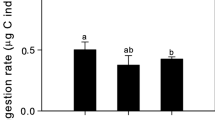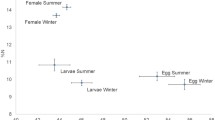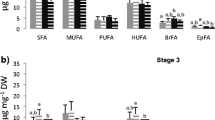Abstract
Previous studies examining the effects of food quality on zooplankton often controlled for maternal effects of resource provisioning using standardized maternal diets. However, varying nutritional history of mothers may change resource provisioning to their progeny, especially regarding polyunsaturated fatty acids (PUFAs), which may change the interpretation of previously observed fitness responses of offspring. To assess PUFA-mediated maternal provisioning effects on offspring, we raised females of the cladoceran Daphnia magna on diets differing considerably in PUFA composition and raised their offspring on a PUFA-lacking diet supplemented with the ω3 PUFAs α-linolenic acid (ALA) and/or eicosapentaenoic acid (EPA). The mass-specific growth responses of offspring to their own diets were affected by the maternal diet regime, probably due to varying maternal PUFA provisioning. A low maternal provisioning of EPA or ALA was sufficient to prevent growth limitation of offspring by these PUFAs until reaching maturity. A comparison with results of published ALA and EPA supplementation experiments suggests that the previously observed limitation effects depended on the usage of a single algae genus as maternal diet. Therefore, we suggest that maternal diets should be deliberately varied in future studies assessing ecological relevant food quality effects on zooplankton, especially regarding PUFAs.





Similar content being viewed by others
References
Agrawal, A. A., C. Laforsch & R. Tollrian, 1999. Transgenerational induction of defences in animals and plants. Nature 401: 60–63.
Alekseev, V. & W. Lampert, 2001. Maternal control of resting-egg production in Daphnia. Nature 414: 899–901.
Becker, C. & M. Boersma, 2003. Resource quality effects on life histories of Daphnia. Limnology & Oceanography 48: 700–706.
Becker, C. & M. Boersma, 2005. Differential effects of phosphorus and fatty acids on Daphnia magna growth and reproduction. Limnology & Oceanography 50: 388–397.
Becker, C. & M. Boersma, 2007. Effects of essential fatty acids on the reproduction of a generalist herbivore. Journal of Plankton Research 29: 463–470.
Boersma, M., 1997. Offspring size and parental fitness in Daphnia magna. Evolutionary Ecology 11: 439–450.
Boersma, M., 2000. The nutritional quality of P-limited algae for Daphnia. Limnology & Oceanography 45: 1157–1161.
Boersma, M. & C. Kreutzer, 2002. Life at the edge: Is food quality really of minor importance at low quantities? Ecology 83: 2552–2561.
Brett, M. T., 1993. Resource quality effects on Daphnia longispina offspring fitness. Journal of Plankton Research 15: 403–412.
Brzezinski, T. & E. Von Elert, 2007. Biochemical food quality effects on a Daphnia hybrid complex. Limnology & Oceanography 52: 2350–2357.
Frost, P. C., D. Ebert, J. H. Larson, M. A. Marcus, N. D. Wagner & A. Zalewski, 2010. Transgenerational effects of poor elemental food quality on Daphnia magna. Oecologia 162: 865–872.
Glazier, D. S., 1992. Effects of food, genotype, and maternal size and age on offspring investment in Daphnia magna. Ecology 73: 910–926.
Guillard, R. R., 1975. Cultures of phytoplankton for feeding of marine invertebrates. In Smith, W. L. & M. H. Chanley (eds), Culture of marine invertebrate animals. Plenum Press, New York: 26–60.
Guisande, C. & Z. M. Gliwicz, 1992. Egg size and clutch size in two Daphnia species grown at different food levels. Journal of Plankton Research 14: 997–1007.
Hartwich, M., D. Martin-Creuzburg, K.-O. Rothhaupt & A. Wacker, 2012. Oligotrophication of a large, deep lake alters food quantity and quality constraints at the primary producer–consumer interface. Oikos 121: 1702–1712.
Hartwich, M., D. Martin-Creuzburg & A. Wacker, 2013. Seasonal changes in the accumulation of polyunsaturated fatty acids in zooplankton. Journal of Plankton Research 35: 121–134.
Hassett, R. P. & E. L. Crockett, 2009. Habitat temperature is an important determinant of cholesterol contents in copepods. The Journal of Experimental Biology 212: 71–77.
Hayashi, Y., L. H. Heckmann, A. Callaghan & R. M. Sibly, 2008. Reproduction recovery of the crustacean Daphnia magna after chronic exposure to ibuprofen. Ecotoxicology 17: 246–251.
Heckmann, L. H., R. M. Sibly, M. J. T. N. Timmermans & A. Callaghan, 2008. Outlining eicosanoid biosynthesis in the crustacean Daphnia. Frontiers in Zoology 5: 11.
Jöhnk, K. D., J. Huisman, J. Sharples, B. Sommeijer, P. M. Visser & J. M. Stroom, 2008. Summer heatwaves promote blooms of harmful cyanobacteria. Global Change Biology 14: 495–512.
Keating, K. I., 1985. The influence of vitamin B12 deficiency on the reproduction of Daphnia pulex Leydig (Cladocera). Journal of Crustacean Biology 5: 130–136.
Koch, U., D. Martin-Creuzburg, H.-P. Grossart & D. Straile, 2011. Single dietary amino acids control resting egg production and affect population growth of a key freshwater herbivore. Oecologia 167: 981–989.
LaMontagne, J. M. & E. McCauley, 2001. Maternal effects in Daphnia: What mothers are telling their offspring and do they listen? Ecology Letters 4: 64–71.
Lampert, W., 1991. The dynamics of Daphnia in a shallow lake. Verhandlungen der internationalen Vereinigung für theoretische und angewandte Limnologie 24: 795–798.
Lukas, M., E. Sperfeld & A. Wacker, 2011. Growth Rate Hypothesis does not apply across colimiting conditions: cholesterol limitation affects phosphorus homoeostasis of an aquatic herbivore. Functional Ecology 25: 1206–1214.
Martin-Creuzburg, D., E. Sperfeld & A. Wacker, 2009. Colimitation of a freshwater herbivore by sterols and polyunsaturated fatty acids. Proceedings of the Royal Society of London Series B: Biological Sciences 276: 1805–1814.
Martin-Creuzburg, D., E. Von Elert & K. H. Hoffmann, 2008. Nutritional constraints at the cyanobacteria-Daphnia magna interface: The role of sterols. Limnology and Oceanography 53: 456–468.
Martin-Creuzburg, D., A. Wacker & T. Basen, 2010. Interactions between limiting nutrients and associated consequences for growth and reproduction of Daphnia magna. Limnology & Oceanography 55: 2597–2607.
Martin-Creuzburg, D., A. Wacker, C. Ziese & M. J. Kainz, 2012. Dietary lipid quality affects temperature-mediated reaction norms of a freshwater key herbivore. Oecologia 168: 901–912.
McGinley, M. A., D. H. Temme & M. A. Geber, 1987. Parental investment in offspring in variable environments: theoretical and empirical considerations. The American Naturalist 130: 370–398.
Metcalfe, N. B. & P. Monaghan, 2001. Compensation for a bad start: grow now, pay later? Trends in Ecology & Evolution 16: 254–260.
Mousseau, T. A. & C. W. Fox, 1998. The adaptive significance of maternal effects. Trends in Ecology & Evolution 13: 403–407.
Müller-Navarra, D. C., 1995. Biochemical versus mineral limitation in Daphnia. Limnology & Oceanography 40: 1209–1214.
Müller-Navarra, D. C., 2006. The nutritional importance of polyunsaturated fatty acids and their use as trophic markers for herbivorous zooplankton: Does it contradict? Archiv für Hydrobiologie 167: 501–513.
Müller-Navarra, D. C., M. T. Brett, A. M. Liston & C. R. Goldman, 2000. A highly unsaturated fatty acid predicts carbon transfer between primary producers and consumers. Nature 403: 74–77.
Paerl, H. W. & J. Huisman, 2008. Climate: Blooms like it hot. Science 320: 57–58.
Pajk, F., E. Von Elert & P. Fink, 2012. Interaction of changes in food quality and temperature reveals maternal effects on fitness parameters of a keystone aquatic herbivore. Limnology & Oceanography 57: 281–292.
Persson, J. & T. Vrede, 2006. Polyunsaturated fatty acids in zooplankton: variation due to taxonomy and trophic position. Freshwater Biology 51: 887–900.
R Core Team, 2012. R: A language and environment for statistical computing. R Foundation for Statistical Computing, Vienna, Austria.
Ravet, J. L., M. T. Brett & D. C. Müller-Navarra, 2003. A test of the role of polyunsaturated fatty acids in phytoplankton food quality for Daphnia using liposome supplementation. Limnology & Oceanography 48: 1938–1947.
Ravet, J. L., J. Persson & M. T. Brett, 2012. Threshold dietary polyunsaturated fatty acid concentrations for Daphnia pulex growth and reproduction. Inland Waters 2: 199–209.
Rossiter, M., 1996. Incidence and consequences of inherited environmental effects. Annual Review of Ecology and Systematics 27: 451–476.
Schlotz, N., J. G. Sørensen & D. Martin-Creuzburg, 2012. The potential of dietary polyunsaturated fatty acids to modulate eicosanoid synthesis and reproduction in Daphnia magna: a gene expression approach. Comparative biochemistry and physiology. Part A, Molecular & integrative physiology 162: 449–454.
Schlotz, N., D. Ebert & D. Martin-Creuzburg, 2013. Dietary supply with polyunsaturated fatty acids and resulting maternal effects influence host-parasite interactions. BMC ecology 13: 41.
Schlotz, N., M. Pester, H. M. Freese & D. Martin-Creuzburg, 2014. A dietary polyunsaturated fatty acid improves consumer performance during challenge with an opportunistic bacterial pathogen. FEMS Microbiology Ecology 90: 467–477.
Sperfeld, E., D. Martin-Creuzburg & A. Wacker, 2012. Multiple resource limitation theory applied to herbivorous consumers: Liebig’s minimum rule vs. interactive co-limitation. Ecology Letters 15: 142–150.
Sperfeld, E. & A. Wacker, 2009. Effects of temperature and dietary sterol availability on growth and cholesterol allocation of the aquatic keystone species Daphnia. The Journal of Experimental Biology 212: 3051–3059.
Sperfeld, E. & A. Wacker, 2011. Temperature- and cholesterol-induced changes in eicosapentaenoic acid limitation of Daphnia magna determined by a promising method to estimate growth saturation thresholds. Limnology & Oceanography 56: 1273–1284.
Sperfeld, E. & A. Wacker, 2012. Temperature affects the limitation of Daphnia magna by eicosapentaenoic acid, and the fatty acid composition of body tissue and eggs. Freshwater Biology 57: 497–508.
Stanley-Samuelson, D. W., 1994. The biological significance of prostaglandins and related eicosanoids in invertebrates. American Zoologist 34: 589–598.
Sterner, R. W., 1993. Daphnia growth on varying quality of Scenedesmus: mineral limitation of zooplankton. Ecology 74: 2351–2360.
Sundbom, M. & T. Vrede, 1997. Effects of fatty acid and phosphorus content of food on the growth, survival and reproduction of Daphnia. Freshwater Biology 38: 665–674.
Taipale, S. J., M. J. Kainz & M. T. Brett, 2011. Diet-switching experiments show rapid accumulation and preferential retention of highly unsaturated fatty acids in Daphnia. Oikos 120: 1674–1682.
Von Elert, E., 2002. Determination of limiting polyunsaturated fatty acids in Daphnia galeata using a new method to enrich food algae with single fatty acids. Limnology & Oceanography 47: 1764–1773.
Von Elert, E., 2004. Food quality constraints in Daphnia: interspecific differences in the response to the absence of a long chain polyunsaturated fatty acid in the food source. Hydrobiologia 526: 187–196.
Von Elert, E., D. Martin-Creuzburg & J. R. Le Coz, 2003. Absence of sterols constrains carbon transfer between cyanobacteria and a freshwater herbivore (Daphnia galeata). Proceedings of the Royal Society of London - Series B: Biological Sciences 270: 1209–1214.
Wacker, A. & E. Von Elert, 2001. Polyunsaturated fatty acids: evidence for non-substitutable biochemical resources in Daphnia galeata. Ecology 82: 2507–2520.
Wacker, A. & D. Martin-Creuzburg, 2007. Allocation of essential lipids in Daphnia magna during exposure to poor food quality. Functional Ecology 21: 738–747.
Wacker, A. & G. Weithoff, 2009. Carbon assimilation mode in mixotrophs and the fatty acid composition of their rotifer consumers. Freshwater Biology 54: 2189–2199.
Wacker, A. & D. Martin-Creuzburg, 2012. Biochemical nutrient requirements of the rotifer Brachionus calyciflorus: co-limitation by sterols and amino acids. Functional Ecology 26: 1135–1143.
Weers, P. M. M., K. Siewertsen & R. D. Gulati, 1997. Is the fatty acids composition of Daphnia galeata determined by the fatty acid composition of the ingested diet? Freshwater Biology 38: 731–738.
Acknowledgements
We thank Silvia Heim and Sabine Donath for technical assistance. This work was supported by the German Research Foundation (Deutsche Forschungsgemeinschaft, Grant Nos SP1473/1-1 to E.S. and WA2445/8-1 to A.W.).
Author information
Authors and Affiliations
Corresponding author
Additional information
Handling editor: Sigrún Huld Jónasdóttir
Electronic supplementary material
Below is the link to the electronic supplementary material.
Rights and permissions
About this article
Cite this article
Sperfeld, E., Wacker, A. Maternal diet of Daphnia magna affects offspring growth responses to supplementation with particular polyunsaturated fatty acids. Hydrobiologia 755, 267–282 (2015). https://doi.org/10.1007/s10750-015-2244-y
Received:
Revised:
Accepted:
Published:
Issue Date:
DOI: https://doi.org/10.1007/s10750-015-2244-y




